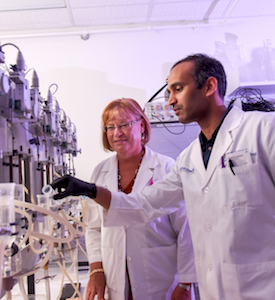Study: Therapeutic combo could ease difficult labors

The long and difficult labors some expectant mothers face may someday be relieved by administering a cervical ripening agent along with an inhibitor of a naturally occurring enzyme, UT Southwestern Medical Center research shows.
“For decades, the mechanisms that serve to promote cervical ripening were not known. Every baby deserves to be well born, and we believe this research moves us in that direction,” said Dr. Ann Word, Professor of Obstetrics and Gynecology at UT Southwestern and senior author of a study describing the findings published in Proceedings of the National Academy of Sciences.
Protracted labor is often caused by the cervix not ripening – meaning softening and thinning – in a timely manner, Dr. Word said.
Induction of cervical ripening – a popular choice for labor initiation – is aided by the use of prostaglandin E2 (PGE2), given orally or by topical gel, at full term. Unfortunately, at least 10 percent of patients do not respond to PGE2, resulting in long labors and an increased risk for cesarean delivery.
In the study performed in mice, UT Southwestern clinicians and biochemists from Obstetrics and Gynecology, Biochemistry, and Clinical Sciences worked to uncover the mechanisms of PGE2-induced cervical ripening and how one enzyme, 15-hydroxy prostaglandin dehydrogenase (15-PGDH), controls its biological activity. Their twofold goal was to demonstrate how the enzyme mediates its effect, and to determine if an inhibitor of 15-PGDH could promote cervical ripening.
“We administered PGE2 and the inhibitor to mice at the same time,” said Dr. Annavarapu Hari Kishore, an Ob/Gyn research scientist who worked with Dr. Word on this research. “They are targeted to the cervix, and by effectively using the inhibitor we can use a lower, and thereby safer, dose of PGE2 to induce ripening.”
The findings provide new insights into induction of cervical ripening at term as well as suggesting possible avenues to eventually prevent preterm cervical dilation. The research team currently continues to use mice while planning to move the effort into guinea pig models.
“We can do more studies in animals right now, but clinical trials with human subjects will require that safety trials be done first,” Dr. Word said. “For now, we want to continue to understand how the signaling cascade works in both animal models, and account for variables in the responses to these treatments.”
Dr. Word holds the Mary Dees McDermott Hicks Chair in Medical Science.



